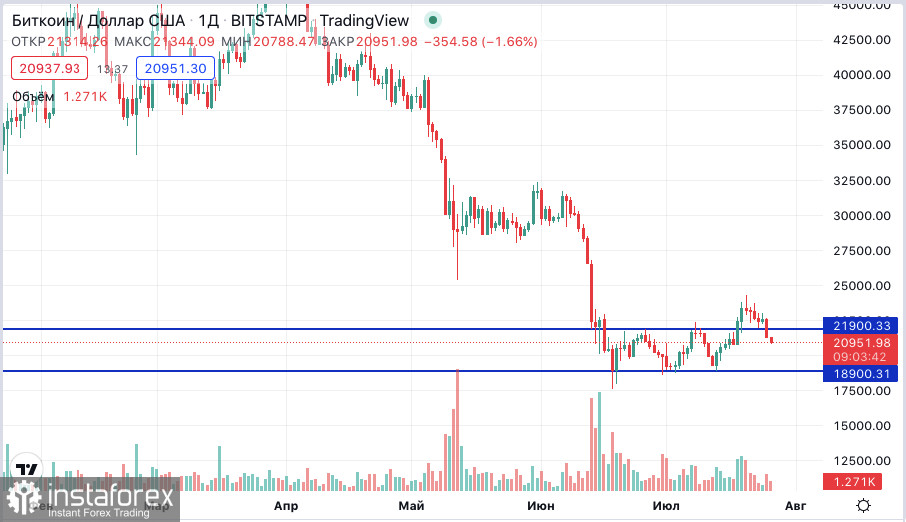Bitcoin failed to hold above the key support of $21,900 per coin. This now gives the major cryptocurrency a chance to head towards support at $18,900.
The Fed's two-day meeting began today. An interest rate hike and the central bank's subsequent plans are expected to be announced on Wednesday. The rhetoric in this case could be far more important than a rate hike, unless of course it is a 1% rise all at once.

Does the current fall and upcoming events mean that the recent rebound is over?
Negative sentiments
Cryptocurrency investors have been on edge since Bitcoin's fall to around $20,000. Many of them fear that more unprecedented selloffs by key players could precipitate a bigger downtrend.
Further declines are likely to amplify losses and make it harder for the market to recover in the medium term. As such, many investors are holding off additional investments.
Besides the fall of cryptocurrencies, the decimation of linchpin crypto firms such as Three Arrows Capital (3AC) and the Celsius Network has also had a negative effect on investor sentiment.
The Singapore-based 3AC hedge fund, for example, collapsed with about $10 billion in investor funds. The recent crypto crash threw the agency into financial turmoil and made it hard for it to repay its creditors and investors.
The Celsius crypto lending network, which was also revered in crypto circles, also fell on hard times when the crypto market dropped. The company was forced to halt payments to creditors and customers due to low liquidity.
Such incidences have upset investor confidence in the industry and reduced capital inflows needed to buttress cryptocurrencies.Margin calls and liquidations
Market participants trading cryptocurrencies using leverage suffer big losses and close on margin, even if the price changes slightly. This generates a wave of liquidations and a new price collapse.
Liquidation occurs when an asset broker forcefully closes an investor's collateralized position due to a loss affecting the initial margin. Liquidations usually amplify market slumps by inadvertently increasing the number of selloffs.
On January 11, for example, BTC futures contracts worth approximately $2.7 billion were liquidated within 24 hours, causing prices to retrogress from about $41,000 to sub $32,000 levels.
A similar occurrence happened on June 14 and caused Bitcoin prices to plummet by about 15%. About $532 million worth of Bitcoin was liquidated as a result.
While liquidations influence prices in the short term, they negatively impact asset prices by increasing market turbulence, which causes uncertainty. Uncertainty is bad for the business because it extends fear cycles.
Inflation vs Bitcoin
Inflation is now being cited as one of the main reasons for the fall in risk assets. During the month of May, the United States Consumer Price Index reached 8.3%. For comparison, it was 0.3% in April 2020 when COVID-19 lockdowns started.
Many analysts theorize that the high inflation rate was brought on by the aggressive fiscal policies adopted by the US government in 2020 in response to the COVID-19 pandemic.
The government lowered Fed interest rates to zero and unleashed a $5 trillion stimulus program to avert an economic disaster — far more than the $787 billion used to quell the 2008 recession.
The funds used during the pandemic buoyed the economy and helped boost demand for goods and services. However, supply chains were unable to keep up with the growing demand for certain commodities, hence the rise in commodity prices.
There are other compounding factors that have led to higher costs of living and less investment in speculative instruments, such as Bitcoin, due to less disposable income.
Nevertheless, cryptocurrency prices can recover as soon as current socioeconomic dynamics change for the better. However, this is a long-term prospect, and in the meantime the fight against inflation is being fought by raising interest rates.
Federal Reserve interest rates
In March, the US Federal Reserve increased the lending rate for the first time since 2020. At the time, Bitcoin prices didn't move by much because the rate was already factored in. However, the announcement prepped investors for upcoming changes and touched off a gradual descent.
On June 15, the Fed raised its lending rate again, this time by three-quarters of a percentage point, which is the highest increase in two decades. The anti-inflation measure caused markets to fall in the subsequent days.
Notably, Bitcoin investors began pulling out of the market a few days after the announcement, causing prices to drop from $30,000 levels to $18,900 between June 7 and June 18.
The reaction was expected because the Fed had already signaled that it would be implementing an interest hike. Fed interest hikes historically reduce investments in speculative assets such as Bitcoin.
What to expect in near future
Bitcoin is set to bottom out in the medium term. This will allow the asset to gain some stability, enough to mollify investors and give rise to bullish sentiment.
Analysts believe that the market is now in a transitional period. This current period is a moment of consolidation and will gain momentum as many who have been on the sidelines waiting for a better price begin to buy in.
Looking locally, within the next two days, the consolidation trend could be considered unchanged with the chances of a recovery remaining as long as Bitcoin stays above $18,900 per coin.





















